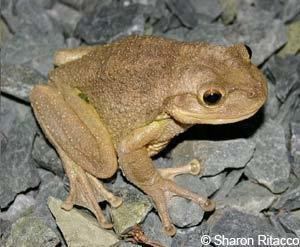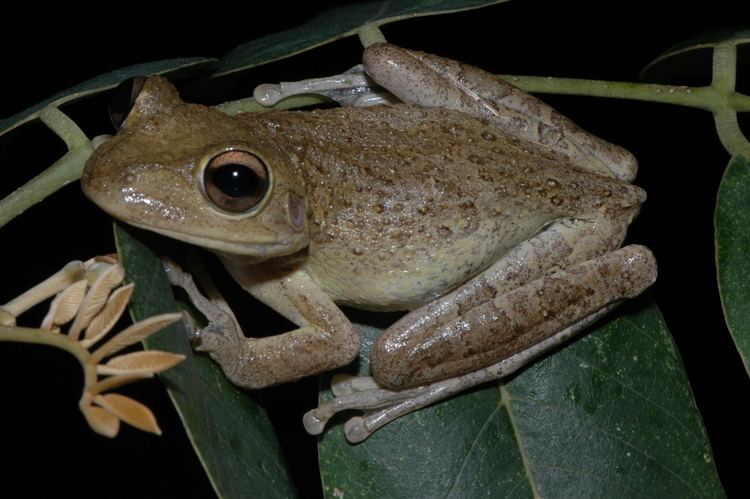Rank Species | Higher classification Osteopilus | |
 | ||
Scientific name Osteopilus septentrionalis Similar Frog, Osteopilus, Amphibians, American green tre, Hylidae | ||
Cuban tree frog barking
The Cuban tree frog (Osteopilus septentrionalis) is an amphibian native to the Caribbean region of the Western Hemisphere. It is the largest tree frog of North America. Its wide diet and ability to thrive amongst humans has made it a highly invasive species with established colonies in northern Florida, the Hawaiian island of Oahu, and throughout the Caribbean Islands. They range in size from 3 to 5.5 in (76 to 140 mm) and vary in color from olive-brown and bronze to gray or grayish-white. A nocturnal, tree-dwelling frog, it is known to eat almost anything that will fit in its mouth and to mate year-round. Cuban tree frogs are commonly available as pets; however, because the animal secretes a toxic mucus from its skin that can cause a burning sensation in the eyes, it is not an ideal pet. Further distribution of the species is believed to have been expanded by the release of these pet animals.
Contents
- Cuban tree frog barking
- Florida s spotted frog the cuban tree frog vs green tree frog
- Description
- Behavior
- Lifecycle
- Distribution
- Conservation
- In captivity
- References

Florida s spotted frog the cuban tree frog vs green tree frog
Description

The Cuban tree frog ranges in size from 3 to 5.5 in (76 to 140 mm) in length. It is the largest tree frog in North America. It has a rough, warty skin. Its toepads are much larger than those of other tree frogs, and it often has an orange tint to its eyes. It varies in color from olive-brown or bronze to gray or grayish-white.

Cuban tree frogs can change colors depending on their temperature and environment. Many individuals have darker splotches on the back, and some splotchy banding on the legs. In many individuals, the hidden surfaces of their legs are bright yellow. When the frog leaps to avoid a predator, these bright-yellow patches are visible, and may help to confuse the predator. Also, the skin on their heads is fused to the skull; if the head of an adult frog is rubbed (between the eyes), the skin does not move. This special adaptation prevents water loss, since fewer blood vessels occur in the "co-ossified" (fused) area. When handled, Cuban tree frogs secrete a toxic mucus from their skin. In humans, this can cause an allergic reaction or burning sensation to the eyes and nose, and even trigger asthma.
Behavior
As excellent climbers, the Cuban tree frogs will typically sleep above ground during the day. During the night, they forage for insects around sources of artificial light. They will eat anything they can overpower and fits into their mouths, including snails, spiders, insects, other frogs (even other Cuban tree frogs), snakes, lizards, small crustaceans, and hatchling birds in their nests. Their foraging will occasionally take them up utility poles, where they can cause short-circuits of utility switches, causing costly power outages.
Lifecycle
Cuban tree frogs are sexually dimorphic – females are larger than males. Breeding males can be identified by their development of black nuptial pads on their thumbs, which help the males to hold onto the females during mating.
Cuban tree frogs breed year round, but most commonly in the wet season, between May and October. Optimal conditions are considered to be 81.5 °F (27.5 °C) with high humidity (97.8%) and rain. They lay a partial clutch of eggs in varying size ranging from 100-1,000. The full clutch is on average a total of 3,961 and varies based on female body size. Eggs can hatch in under 30 hours and can fully develop in one month. Much like their adult counterparts, newly hatched tadpoles occur in a variety of colors and patterns. They have wide caudal fins and two rows of labial teeth on the top of their mouths and four rows on the bottom. Tadpoles survive on algae and will occasionally eat other tadpoles, and, on rare occasions, recently metamorphism juveniles. After transformation, they are between 0.55 and 0.67 inches (14 and 17 mm) long, and their tails are entirely absorbed.
Distribution
The Cuban tree frog is native to Cuba, the Bahamas, and the Cayman Islands. This large frog has been introduced in Puerto Rico, the US Virgin Islands, the British Virgin Islands, many islands of the Lesser Antilles, and Hawaii. Whether the species was native to the Key West region of Florida is debated, or if it was introduced to the area. First discovered in the 1930s, they may have arrived on ships in the 1800s or could have made it to the area by natural means. They can survive in brackish water, which may have helped the species to spread to various islands. The Cuban tree frogs' progressive colonization into the mainland of Florida is believed to be abetted by use of State Road A1A construction during the 1940s. The species is now established in southern Florida and parts of the panhandle region, and can be found as far north as South Carolina.
The Cuban tree frog is known to hitchhike on shipments of potted plants, vegetation, packaging, boats, and other motorized vehicles. Once in a new location, the frogs become an invasive species. They have several good colonizing traits, such as high fecundity, short generation time, a diverse diet, good competitive ability, and the ability to coexist with humans. In addition, they also secrete a toxic mucus from their skin which helps to limit the number of natural predators.
Cuban tree frogs are known to inhabit a variety of habitats, including estuaries, low-density suburban development, small towns, agricultural areas, particularly ones with exotic plants, and lowland forests and swamps. Within their habitats, they can be found in damp, shady areas, particularly around shrubs and trees, by cisterns, rain barrels, and buildings.
Conservation
This large frog directly impacts native ecosystems by eating native frogs, lizards, and snakes, and poses a threat to the biodiversity of the areas into which it spreads by causing native tree frog populations to decline. These effects are most noticeable in urban and suburban areas, where native tree frogs, such as the American green tree frog (Hyla cinerea) and the squirrel treefrog (Hyla squirella) are rapidly disappearing. It has spread throughout peninsular Florida, and is also commonly found in isolated populations as far north as southern Georgia. It is inadvertently carried on vehicles or ornamental plants, spreading to new areas, and has been transported as far north and west as Saskatchewan, Canada. Because of its effects on the biodiversity, some experts have recommended killing the animal when it is found in a new habitat. This can be done, most humanely, through the application of Orajel to the abdominal skin, waiting fifteen minutes for the frog to be fully anaesthetized, and then placing it in a freezer for a few hours.
In captivity
Cuban tree frogs are commonly available in the pet trade within the United States. They are inexpensive, and when cared for properly, tend to live five to 10 years. They feed readily on commercially available crickets, but while in captivity, they may turn to cannibalism. Their toxic mucus can burn the eyes and trigger an allergic (or asthmatic) reaction; as a result, this species is not an ideal pet species, especially for children. The Cuban tree frog's colonization of Oahu is believed to be a result of accidental or deliberate release of pets. Therefore, the species is now banned from sale in Hawaii. Conviction of importation of a Cuban tree frog carries a maximum fine of $25,000 and a year in jail.
